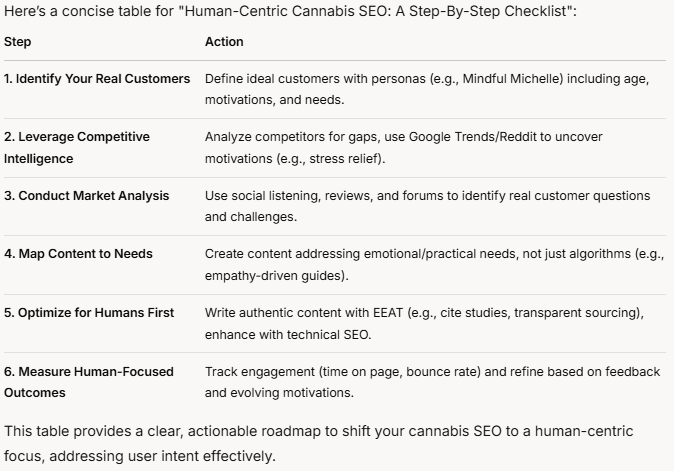Key Points
- Research suggests that most SEO, including in cannabis, starts with a flawed focus on “users” as data points, not people with emotions and motivations.
- It seems likely that understanding customer personas, like stressed CBD seekers or legally confused entrepreneurs, improves cannabis SEO by addressing deeper needs.
- The evidence leans toward human-centric SEO, focusing on “why” behind searches, as a competitive edge in 2025, especially with AI reducing clicks.
Most cannabis SEO strategies share one critical mistake: they treat users as data points rather than as actual human beings.
Too often, marketing teams obsess over keywords, metrics, and technical checklists—forgetting the simple truth: behind every search query is a person with real motivations, emotions, and desires.
At Hemp Writer, we believe that great cannabis SEO begins by deeply understanding who your customers are—beyond what they type into Google.
In this article, we’ll explore why competitive intelligence and market analysis for cannabis SEO should always start with real people, and how this simple shift can dramatically transform your digital strategy.
The Fundamental Flaw Of Cannabis SEO
Typical cannabis SEO is often built on assumptions about user intent. It assumes:
- A search for “CBD oil near me” automatically signals a desire to buy locally.
- A query for “best cannabis edibles” inherently means someone is ready to purchase products online.
- Keyword data alone reveals all you need to optimize for higher rankings.
But here’s the problem: queries aren’t people.
A keyword doesn’t reveal who the person is or why they’re truly searching.
By focusing exclusively on search intent data, most cannabis SEO campaigns miss the mark, failing to deliver meaningful content to actual humans.
Why Traditional SEO Falls Short In Cannabis
Traditional SEO often assumes customers are ready to buy based on their search, like interpreting “best THC gummies” as a buying signal.
But in cannabis, this misses the mark.
For example, someone searching “CBD for anxiety” might be stressed and seeking relief, not just shopping.
Or a parent querying “THC-free gummies for kids” could be researching safety, not ready to purchase.
These motivations—stress, legal fears, health concerns—drive searches, yet SEO frameworks often ignore them, focusing on intent alone.
In 2025, with AI overviews reducing clicks and social media restrictions limiting cannabis ads, this approach is riskier.
Optimizing for algorithms won’t connect with people; you need to understand the “why” behind their searches to stand out.
People, Not Just Queries: Why Understanding Customers Matters
Think beyond the keyword for a moment.
Ask yourself.
- Who is your customer, really?
- What’s driving them to search right now?
- What emotions or personal circumstances influence their search?
Imagine these scenarios.
- Someone searching for “CBD gummies for anxiety” might actually be overwhelmed by stress, needing immediate emotional reassurance rather than just a product list.
- A user searching “cannabis SEO agency” might be feeling frustrated after failed attempts to rank organically, urgently seeking a trusted professional to handle their marketing.
These are human realities, not just abstract queries.
Cannabis users and buyers have deeply personal motivations, and your SEO strategy must address these first if you want to stand out.
Shifting To Human-Centric SEO For Cannabis
The solution is simple but powerful: ask, “Who is your customer?” Beyond the query, what compels them to search? Let’s look at examples.
- Mindful Michelle, a 35-year-old yoga instructor, searches “organic CBD oil for anxiety.” She values sustainability and uses cannabis to manage stress during meditation, seeking trust and alignment with her values.
- Legal Larry, a 45-year-old entrepreneur, searches “cannabis laws by state.” He’s confused about legality for his new dispensary, needing clarity, not a sale.
- Stressed Sarah, a 30-year-old nurse, searches “CBD for sleep.” She’s overworked, seeking relief from insomnia, wanting content that empathizes and educates.
These personas show cannabis customers have diverse needs—health, legal, emotional—that queries alone don’t reveal.
Human-centric SEO means creating content that addresses these whys, like guides on “How CBD Helps Manage Stress” for Sarah, legal FAQs for Larry, or organic product spotlights for Michelle.
This builds trust, aligns with EEAT (experience, expertise, authoritativeness, trustworthiness), and drives conversions beyond clicks.

Human-Centric Cannabis SEO: A Step-By-Step Checklist
Transform your SEO approach from query-focused to human-focused using the following checklist.
Step 1: Identify Your Real Customers
- Clearly define your ideal cannabis customers, including their age, interests, values, and lifestyle.
- Create detailed personas (e.g., Mindful Michelle, Legal Larry) with age, motivations, and pain points.
- Understand their emotional and practical motivations behind typical cannabis-related searches.
Step 2: Leverage Competitive Intelligence
Research Motivations.
- Analyze competitors’ sites to see how they address (or fail to address) human motivations.
- Identify gaps in content that don’t align with genuine customer needs or emotions.
- Use tools like Google Trends or social listening on Reddit to uncover why they search (e.g., stress relief, legal clarity).
Step 3: Conduct Market Analysis
- Use social listening, forums, and cannabis community platforms to uncover real questions and challenges customers discuss daily.
- Observe customer reviews, social posts, and feedback to understand deeper motivations behind common search queries.
Step 4: Map Content To Needs – Emotional And Practical Motivations
- Develop detailed content strategies addressing the true emotional and practical needs of your audience.
- Create content and landing pages that directly address real human experiences, rather than merely satisfying search algorithms.
Step 5: Optimize Content For Humans First, Algorithms Second
- Write content that resonates authentically, demonstrating empathy, trustworthiness, and clarity.
- Optimize for EEAT: Ensure content reflects expertise (e.g., cite studies on CBD benefits) and trustworthiness (e.g., transparent hemp sourcing) to build credibility and connect with users.
- Implement technical SEO best practices (speed, structure, links) to enhance—never overshadow—user experience.
Step 6: Measure Human-Focused Outcomes
- Track engagement metrics (time on page, bounce rate, return visits) alongside traditional SEO metrics (rankings, CTR).
- Continuously refine content to align more closely with evolving human motivations and feedback.
Practical Examples: Human-Centric Cannabis SEO
Here’s how shifting to a human-first SEO approach might look in practice:
Query: “THC cartridges near me”
- Traditional approach: Optimizing for geographic keywords to improve local visibility.
- Human-centric approach: Creating content addressing concerns about cartridge safety, quality assurance, and personal experiences, along with clear pathways to local purchasing options.
Query: “Best cannabis marketing agencies”
- Traditional approach: Optimizing agency pages with keyword-heavy text.
- Human-centric approach: Understanding that visitors may be stressed business owners or marketers overwhelmed by compliance regulations, creating trust-building content demonstrating deep cannabis industry expertise.
Move Beyond Queries—Start With People
To truly succeed in cannabis SEO, shift your focus toward real human experiences and motivations.
At Hemp Writer, we’ve seen firsthand how understanding your audience as humans—not just as “users”—is a powerful competitive advantage.
For personalized support implementing this user-centric cannabis SEO strategy, visit our Cannabis SEO Service page and learn how we can transform your online presence.
Final Thoughts: Humans First, Always
SEO isn’t about pleasing algorithms—it’s about serving people.
By putting genuine human motivations at the heart of your cannabis SEO strategy, you’ll attract more engaged, loyal customers ready to connect with your brand on a deeper level.
After all, your users aren’t data points.
They’re people, too.



